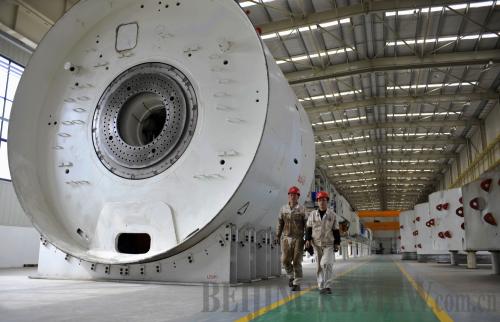|
 |
|
PICKING UP STEAM: Two staff members walk through a workshop of the China Railway Construction Heavy Industry Co. Ltd. in Lanzhou New District, Gansu Province. The new district is designed to be an industrial base in west China (CHEN BIN) |
"China needs to expand its channels and sources for oil imports because imported oil will account for 75 percent of domestic consumption by 2020," He said. "The countries on the 'new Silk Road' must work together to maintain the stability of the region and help China to combat separatist, extremist and terrorist forces," he said.
Wu Dongli, Director of the Border Control Department of the Ministry of Public Security, said stronger trade ties with Eurasian countries will help China combat terrorism.
Terrorist activities in China have become more prevalent in recent years, which have triggered panic among the public and endangered state security, Wu said.
"China needs to strengthen international cooperation in fighting terrorism. Stronger trade and cultural relationships with other countries in the region would be hugely beneficial for those aims," he said.
Fierce competition
Although specific policy support and detailed guidance for the proposed belt have yet to be released by China's Central Government, cities along the proposed route are in fierce competition to grab a slice of the action.
Lou Qinjian, Governor of northwest China's Shaanxi Province, said Shaanxi should spearhead this round of opening up to the west.
Dong Jun, Mayor of Xi'an, capital of Shaanxi, said the city is anxious to reclaim its position as a hub of trade and cultural communications. Xi'an was the original starting point of the ancient Silk Road.
Liu Hui, Chairwoman of northwest China's Ningxia Hui Autonomous Region, argues the area's large Muslim population means it shares cultural ties with several countries in central Asia. The region is also seeking deeper international cooperation in the halal food industry, Liu said.
Wang Xiao, Vice Governor of northwest China's Qinghai Province, claimed that Qinghai will establish itself as the green channel, strategic base and important stop of the proposed belt.
"It's a vital development opportunity for Qinghai. Qinghai connects the 1 billion people or so in the Middle East and central Asia that belong to the Muslim culture with the Southeast Asian population who belong to the Buddhist culture. It is the crosspoint of two such cultures and can serve as the springboard of China's connection to those regions," said Wang. Qinghai plans to establish a roundtable meeting with countries along the Silk Road Economic Belt and build a grand bazaar with Turkmenistan and Nepal.
Huang Qifan, Mayor of southwest China's Chongqing Municipality, said the city has advantages in becoming the beginning of the new Silk Road.
"Having the perfect geographical location, Chongqing enjoys convenient transportation by road, railway, water and air," Huang said. "Chongqing is one step ahead in taking the initiative in the economic belt." It has been shipping goods to Europe via the trans-Eurasian railway network since 2011.
Further to the northwest, preparations are also underway in Gansu Province, which, in addition to the potential trade benefits the economic belt will bring, is keen to become a leader in the cultural sphere.
To that end, Gansu is applying to launch a permanent International Culture Exhibition in Dunhuang, which is famous for its well-preserved grottoes and frescoes, said Lian Ji, Director of the Publicity Department of the Gansu Provincial Committee of the Communist Party of China.
"The exhibition will invite other countries along the Silk Road to participate, and we hope the Central Government and the relevant ministries will approve the proposal soon," Lian said.
As the home of the westernmost section of the Eurasian Land Bridge at the Chinese end, Xinjiang spares no efforts in exploiting its location on the new Silk Road to become a transport, finance and logistics hub.
| 